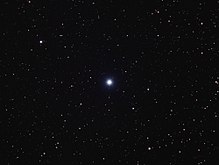Phi Andromedae
| Observation data Epoch J2000 Equinox J2000 | |
|---|---|
| Constellation | Andromeda |
| Right ascension | 01h 09m 30.12562s[1] |
| Declination | +47° 14′ 30.4594″[1] |
| Apparent magnitude (V) | 4.25[2] (4.46/6.06)[3] |
| Characteristics | |
| Spectral type | B7 Ve[4] + B9 V[3] |
| U−B color index | –0.34[2] |
| B−V color index | –0.07[2] |
| R−I color index | –0.05 |
| Astrometry | |
| Radial velocity (Rv) | –0.1[5] km/s |
| Proper motion (μ) | RA: +4.05[1] mas/yr Dec.: –12.43[1] mas/yr |
| Parallax (π) | 4.55 ± 0.60 mas[1] |
| Distance | approx. 720 ly (approx. 220 pc) |
| Absolute magnitude (MV) | −2.41[6] |
| Orbit[7] | |
| Companion | φ And B |
| Period (P) | 554.3 ± 67.1y yr |
| Semi-major axis (a) | 0.573 ± 0.051″ |
| Eccentricity (e) | 0.385 ± 0.043 |
| Inclination (i) | 142.2 ± 2.8° |
| Longitude of the node (Ω) | 337.2 ± 3.2° |
| Periastron epoch (T) | 17,740 ± 1,837 HMJD |
| Argument of periastron (ω) (secondary) | 112.6 ± 9.1° |
| Details | |
| φ And A | |
| Luminosity | 882[6] L☉ |
| Surface gravity (log g) | 3.150[8] cgs |
| Temperature | 13490[8] K |
| Rotational velocity (v sin i) | 75[9] km/s |
| Age | 63.1 ± 13.7[10] Myr |
| Other designations | |
| Database references | |
| SIMBAD | data |

Phi Andromedae (φ Andromedae, φ And) is the Bayer designation for a binary star[3] system near the border of the northern constellation of Andromeda. This system has a combined apparent visual magnitude of 4.25[2] and is visible to the naked eye. Based upon parallax measurements made during the Hipparcos mission, this star system is located at a distance of about 720 light-years (220 parsecs) from Earth.[1] With χ And it forms the Chinese asterism 軍南門 (Keun Nan Mun, Mandarin jūnnánmén), "the South Gate of the Camp".[12][13]
Components
[edit]The 4.46[3] magnitude primary component is a Be star with a stellar classification of B7 Ve, indicating that it is a B-type main sequence star that shows prominent emission lines of hydrogen in its spectrum. These emission lines come from a flattened decretion disk of hot gas that is orbiting the host star.[4] The star is rotating rapidly with a projected rotational velocity of 75 km/s.[9] The pole of the star is inclined around 20° to the line of sight from the Earth.[4]
The 6.06 magnitude companion star is a B-type main sequence star with a classification of B9 V. On average the two stars are separated by about 0.6 arcseconds and have an orbital period of roughly 554 years. Based upon their orbital elements, the system has a combined mass of around 6.5 ± 2.8[7] times the mass of the Sun.
References
[edit]- ^ a b c d e f van Leeuwen, F. (November 2007), "Validation of the new Hipparcos reduction", Astronomy and Astrophysics, 474 (2): 653–664, arXiv:0708.1752, Bibcode:2007A&A...474..653V, doi:10.1051/0004-6361:20078357, S2CID 18759600.
- ^ a b c d Johnson, H. L.; et al. (1966), "UBVRIJKL photometry of the bright stars", Communications of the Lunar and Planetary Laboratory, 4 (99): 99, Bibcode:1966CoLPL...4...99J.
- ^ a b c d Eggleton, P. P.; Tokovinin, A. A. (September 2008), "A catalogue of multiplicity among bright stellar systems", Monthly Notices of the Royal Astronomical Society, 389 (2): 869–879, arXiv:0806.2878, Bibcode:2008MNRAS.389..869E, doi:10.1111/j.1365-2966.2008.13596.x, S2CID 14878976.
- ^ a b c Silaj, J.; et al. (March 2010), "A Systematic Study of Hα Profiles of Be Stars", The Astrophysical Journal Supplement, 187 (1): 228–250, Bibcode:2010ApJS..187..228S, doi:10.1088/0067-0049/187/1/228, S2CID 122679154.
- ^ Wilson, Ralph Elmer (1953), "General catalogue of stellar radial velocities", Carnegie Institute Washington D.C. Publication, Carnegie Institution of Washington, Bibcode:1953GCRV..C......0W. Accessed 2007-05-14.
- ^ a b Anderson, E.; Francis, Ch. (2012), "XHIP: An extended hipparcos compilation", Astronomy Letters, 38 (5): 331, arXiv:1108.4971, Bibcode:2012AstL...38..331A, doi:10.1134/S1063773712050015, S2CID 119257644.
- ^ a b Muterspaugh, Matthew W.; et al. (December 2010), "The Phases Differential Astrometry Data Archive. II. Updated Binary Star Orbits and a Long Period Eclipsing Binary", The Astronomical Journal, 140 (6): 1623–1630, arXiv:1010.4043, Bibcode:2010AJ....140.1623M, doi:10.1088/0004-6256/140/6/1623, S2CID 6030289.
- ^ a b Soubiran, Caroline; et al. (2016), "The PASTEL catalogue: 2016 version", Astronomy & Astrophysics, 591: A118, arXiv:1605.07384, Bibcode:2016A&A...591A.118S, doi:10.1051/0004-6361/201628497, S2CID 119258214.
- ^ a b Abt, Helmut A.; Levato, Hugo; Grosso, Monica (July 2002), "Rotational Velocities of B Stars", The Astrophysical Journal, 573 (1): 359–365, Bibcode:2002ApJ...573..359A, doi:10.1086/340590.
- ^ Tetzlaff, N.; Neuhäuser, R.; Hohle, M. M. (January 2011), "A catalogue of young runaway Hipparcos stars within 3 kpc from the Sun", Monthly Notices of the Royal Astronomical Society, 410 (1): 190–200, arXiv:1007.4883, Bibcode:2011MNRAS.410..190T, doi:10.1111/j.1365-2966.2010.17434.x, S2CID 118629873.
- ^ "* phi And". SIMBAD. Centre de données astronomiques de Strasbourg. Retrieved 2012-06-25.
- ^ Allen, R. H. (1899), Star-names and Their Meanings, New York: G. E. Stechart, p. 39.
- ^ In Chinese literature, φ Andromedae is stand alone in the asterism and χ Andromeda is member of Tien Ta Tseang (Heaven's Great General) asterism, see (in Chinese) AEEA (Activities of Exhibition and Education in Astronomy) 天文教育資訊網 2006 年 7 月 9 日 Archived 2011-05-22 at the Wayback Machine and (in Chinese) AEEA (Activities of Exhibition and Education in Astronomy) 天文教育資訊網 2006 年 7 月 10 日 Archived 2011-07-16 at the Wayback Machine

